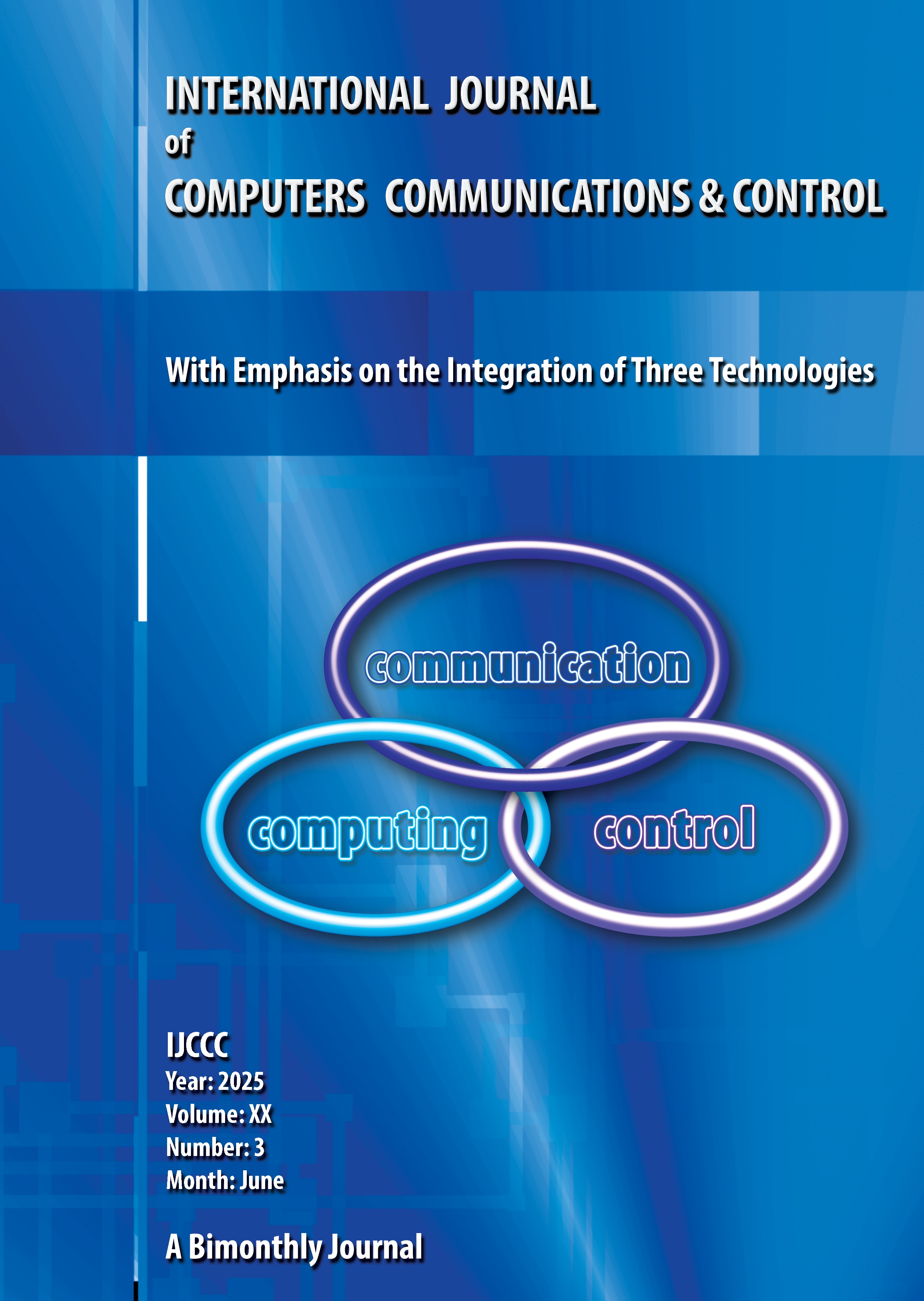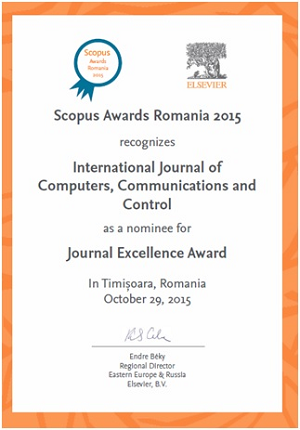MADMN: A Multi-modal Attention and Dynamic Memory Network for Early Mortality Risk Prediction in Electronic Medical Records
DOI:
https://doi.org/10.15837/ijccc.2025.3.6968Keywords:
Multimodal Data Analysis, Dynamic Memory Network, Cross-modal Attention, Electronic Medical Records, Risk PredictionAbstract
This paper proposes a novel Multi-modal Attention and Dynamic Memory Network (MADMN) model for early mortality risk prediction based on Electronic Medical Records (EMRs). The model integrates multi-modal feature extraction, cross-modal attention fusion, and dynamic memory networks within a unified framework to process structured, time-series, and textual data. MADMN effectively captures complex temporal dependencies and multimodal interactions, enhancing prediction accuracy and interpretability. Experimental results demonstrate that MADMN significantly outperforms traditional machine learning and deep learning baselines in terms of Accuracy, F1 Score, and ROC-AUC. Furthermore, SHAP analysis validates the model’s interpretability by highlighting key features contributing to predictions. The model also supports counterfactual analysis, enabling personalized treatment decisions and resource optimization. MADMN offers a robust and interpretable solution for multimodal medical data analysis and risk prediction, paving the way for advancements in precision medicine.
References
Banerjee, J., Taroni, J. N., Allaway, R. J., Prasad, D. V., Guinney, J., & Greene, C. (2023). Machine learning in rare disease. Nature Methods, 20(6), 803-814.
Rahman, S., Hasan, M., & Sarkar, A. K. (2023). Prediction of brain stroke using machine learning algorithms and deep neural network techniques. European Journal of Electrical Engineering and Computer Science, 7(1), 23-30.
Oh, J.W. (2022). A study on digital healthcare service in big data environment: focusing on diagnosis of hyperlipidemia based on diagnostic testing. Journal of System and Management Sciences, 12(3), 345-360. https://doi.org/10.33168/JSMS.2022.0317
Haque, R., Ho, S.B., Chai, I., Abdullah, A. (2023). Improved Adam-based feedforward deep neural network model for personalized asthma predictions. Journal of System and Management Sciences, 13(2), 241-257. https://doi.org/10.33168/JSMS.2023.0217
Kim, Y.S., Song, H.J., Han, J. (2022). A Deepfake-Based Deep Learning Algorithm for Medical Data Manipulation Detection. Journal of System and Management Sciences, 12(1), 13-24. https://doi.org/10.33168/JSMS.2022.0102
Yuantai, X. (2023). Discrete Chaotic Fuzzy Neural Network (DC-FNN) Based Smart Watch Embedded Devices for Sports and Health Monitoring. Tehnički vjesnik, 30(6), 1784-1790. https://doi.org/10.17559/TV-20230222000374
Aminizadeh, S., Heidari, A., Toumaj, S., Darbandi, M., Navimipour, N. J., Rezaei, M., . . .& Unal, M. (2023). The applications of machine learning techniques in medical data processing based on distributed computing and the Internet of Things. Computer Methods and Programs in Biomedicine, 107745.
Feng, J., Zhang, R., Chen, D., Shi, L., & Li, Z. (2024). Automated generation of ICD-11 cluster codes for precision medical record classification. International Journal of Computers Communications & Control, 19(1). https://doi.org/10.15837/ijccc.2024.1.6251
Morid, M. A., Sheng, O. R. L., & Dunbar, J. (2023). Time series prediction using deep learning methods in healthcare. ACM Transactions on Management Information Systems, 14(1), 1-29.
Foersch, S., Glasner, C., Woerl, A. C., Eckstein, M., Wagner, D. C., Schulz, S., . . .& Jesinghaus, M. (2023). Multistain deep learning for prediction of prognosis and therapy response in colorectal cancer. Nature Medicine, 29(2), 430-439.
Fremond, S., Andani, S., Wolf, J. B., Dijkstra, J., Melsbach, S., Jobsen, J. J., . . .& Bosse, T. (2023). Interpretable deep learning model to predict the molecular classification of endometrial cancer. The Lancet Digital Health, 5(2), e71-e82.
Saeedi, S., Rezayi, S., Keshavarz, H., & R. Niakan Kalhori, S. (2023). MRI-based brain tumor detection using convolutional deep learning methods. BMC Medical Informatics and Decision Making, 23(1), 16.
Curila, S., Buciu, I., Grava, C., Trip, D. N., & Straciuc, O. M. (2024). COVID-19 lung infection segmentation using statistics and active contour. International Journal of Computers Communications & Control, 19(6). https://doi.org/10.15837/ijccc.2024.6.6862
Mahmood, M. A., Alsalem, K., Elbashir, M., El-Ghany, S. A., & Abd El-Aziz, A. (2024). Acute knee injury detection with MRI. International Journal of Computers Communications & Control, 19(5). https://doi.org/10.15837/ijccc.2024.5.6648
Vrbančič, G., Pečnik, Š., & Podgorelec, V. (2022). Hyper-parameter Optimization for COVID-19 X-ray Classification. Computer Science and Information Systems, 19(1), 327-352. https://doi.org/10.2298/CSIS210209056V
Singh, A., Pannu, H. S., & Malhi, A. (2022). Explainable Information Retrieval using Deep Learning for Medical Images. Computer Science and Information Systems, 19(1), 277-307. https://doi.org/10.2298/CSIS201030049S
Babu, P. A., Rao, B. V. S., Reddy, Y. V. B., Kumar, G. R., Rao, J. N., Reddy, S. K., & Kumar, G. S. (2023). Optimized CNN-based brain tumor segmentation and classification using artificial bee colony and thresholding. International Journal of Computers Communications & Control, 18(1). https://doi.org/10.15837/ijccc.2023.1.4577
Lee, M. H., Zea, R., Garrett, J. W., Summers, R. M., & Pickhardt, P. J. (2025). AI-based abdominal CT measurements of orthotopic and ectopic fat predict mortality and cardiometabolic disease risk in adults. European Radiology, 35(1), 520-531.
Placido, D., Yuan, B., . . .& Sander, C. (2023). A deep learning algorithm to predict pancreatic cancer. Nature Medicine, 29(5), 1113-1122.
Forrest, I. S., Petrazzini, B. O., . . .& Do, R. (2023). Marker for coronary artery disease validation. The Lancet, 401(10372), 215-225.
Renc, P., Jia, Y., Samir, A. E., Was, J., Li, Q., Bates, D. W., & Sitek, A. (2024). Zero shot health trajectory prediction using transformer. NPJ Digital Medicine, 7(1), 256.
Yang, J., Soltan, A. A., . . .& Clifton, D. A. (2023). Bias mitigation for clinical ML. Nature Machine Intelligence, 5(8), 884-894. based on distributed computing and the Internet of Things. Computer Methods and Programs in Biomedicine, 107745.
Feng, J., Zhang, R., Chen, D., Shi, L., & Li, Z. (2024). Automated generation of ICD-11 cluster codes for precision medical record classification. International Journal of Computers Communications & Control, 19(1). https://doi.org/10.15837/ijccc.2024.1.6251
Morid, M. A., Sheng, O. R. L., & Dunbar, J. (2023). Time series prediction using deep learning methods in healthcare. ACM Transactions on Management Information Systems, 14(1), 1-29.
Foersch, S., Glasner, C., Woerl, A. C., Eckstein, M., Wagner, D. C., Schulz, S., . . .& Jesinghaus, M. (2023). Multistain deep learning for prediction of prognosis and therapy response in colorectal cancer. Nature Medicine, 29(2), 430-439.
Fremond, S., Andani, S., Wolf, J. B., Dijkstra, J., Melsbach, S., Jobsen, J. J., . . .& Bosse, T.
(2023). Interpretable deep learning model to predict the molecular classification of endometrial cancer. The Lancet Digital Health, 5(2), e71-e82.
Saeedi, S., Rezayi, S., Keshavarz, H., & R. Niakan Kalhori, S. (2023). MRI-based brain tumor detection using convolutional deep learning methods. BMC Medical Informatics and Decision Making, 23(1), 16.
Curila, S., Buciu, I., Grava, C., Trip, D. N., & Straciuc, O. M. (2024). COVID-19 lung infection segmentation using statistics and active contour. International Journal of Computers Communications & Control, 19(6). https://doi.org/10.15837/ijccc.2024.6.6862
Mahmood, M. A., Alsalem, K., Elbashir, M., El-Ghany, S. A., & Abd El-Aziz, A. (2024). Acute knee injury detection with MRI. International Journal of Computers Communications & Control, 19(5). https://doi.org/10.15837/ijccc.2024.5.6648
Vrbančič, G., Pečnik, Š., & Podgorelec, V. (2022). Hyper-parameter Optimization for COVID-19 X-ray Classification. Computer Science and Information Systems, 19(1), 327-352. https://doi.org/10.2298/CSIS210209056V
Singh, A., Pannu, H. S., & Malhi, A. (2022). Explainable Information Retrieval using Deep Learning for Medical Images. Computer Science and Information Systems, 19(1), 277-307. https://doi.org/10.2298/CSIS201030049S
Babu, P. A., Rao, B. V. S., Reddy, Y. V. B., Kumar, G. R., Rao, J. N., Reddy, S. K., & Kumar, G. S. (2023). Optimized CNN-based brain tumor segmentation and classification using artificial bee colony and thresholding. International Journal of Computers Communications & Control, 18(1). https://doi.org/10.15837/ijccc.2023.1.4577
Lee, M. H., Zea, R., Garrett, J. W., Summers, R. M., & Pickhardt, P. J. (2025). AI-based abdominal CT measurements of orthotopic and ectopic fat predict mortality and cardiometabolic disease risk in adults. European Radiology, 35(1), 520-531.
Placido, D., Yuan, B., . . .& Sander, C. (2023). A deep learning algorithm to predict pancreatic cancer. Nature Medicine, 29(5), 1113-1122.
Forrest, I. S., Petrazzini, B. O., . . .& Do, R. (2023). Marker for coronary artery disease validation. The Lancet, 401(10372), 215-225.
Renc, P., Jia, Y., Samir, A. E., Was, J., Li, Q., Bates, D. W., & Sitek, A. (2024). Zero shot health trajectory prediction using transformer. NPJ Digital Medicine, 7(1), 256.
Yang, J., Soltan, A. A., . . .& Clifton, D. A. (2023). Bias mitigation for clinical ML. Nature Machine Intelligence, 5(8), 884-894.
Additional Files
Published
Issue
Section
License
Copyright (c) 2025 Yufei Chen, Kai Chen

This work is licensed under a Creative Commons Attribution-NonCommercial 4.0 International License.
ONLINE OPEN ACCES: Acces to full text of each article and each issue are allowed for free in respect of Attribution-NonCommercial 4.0 International (CC BY-NC 4.0.
You are free to:
-Share: copy and redistribute the material in any medium or format;
-Adapt: remix, transform, and build upon the material.
The licensor cannot revoke these freedoms as long as you follow the license terms.
DISCLAIMER: The author(s) of each article appearing in International Journal of Computers Communications & Control is/are solely responsible for the content thereof; the publication of an article shall not constitute or be deemed to constitute any representation by the Editors or Agora University Press that the data presented therein are original, correct or sufficient to support the conclusions reached or that the experiment design or methodology is adequate.








